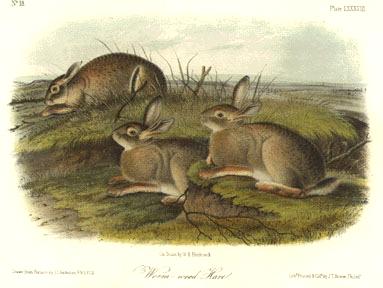

88 Worm-wood Hare
LEPUS ARTEMISIA.--Bach.
[Sylvilagus audubonii]
WORM-WOOD HARE.
[Desert Cottontail]
PLATE LXXXVIII.--MALES AND FEMALE.
L. Parvus, canescens, nucha et cruribus dilute ferugineis, cauda supra
canescens, subtus alba, gula et ventre albis, vellere toto ad basin cano;
auriculis longitudine capitis, tarsus dense vestitis.
CHARACTERS.
Small; of a gray colour, pale rufus on the back of the neck and legs; tail,
above, the colour of the body; beneath, white; under parts of the neck, and
lower surface of the body, white; all the fur gray at the base; ears as long as
the head; tarsus, well clothed.
SYNONYMES.
LEPUS ARTEMISIA. Bach, Worm-wood Hare. Journal Acad. Nat. Sciences,
vol. 8, p. 1, p. 94.
DESCRIPTION.
This small Hare is a little less than our common gray Rabbit, the ears are
longer and more conspicuous. The head is much arched, and the upper incisors
deeply grooved.
COLOUR.
This species is grayish-black and brownish-white above; the fur is soft,
pale-gray at the base, shaded into brownish externally, annulated with
brownish-white near the apex, and black at the tips; under parts, and inner
sides of the limbs, white; the hairs pale-gray at the base; neck, with the hairs
on the sides, and under parts gray, tipped with brownish-white, having a faint
yellow hue; chin and throat grayish-white, the hairs being gray at their base,
and white at their tips. The whole back of the neck and limbs exteriorly of a
pale rusty-fawn colour; hairs on the neck uniform to the base; soles of the
feet, very pale soiled yellowish-brown; tail, coloured above as the back, with
an admixture of grayish-black hairs, beneath, white; ears, externally on the
anterior part, coloured as the crown of the head; posteriorly, ashy white; at
the apex margined with black; internally, nearly naked, excepting the posterior
part, where they are grizzled with grayish black and white; in the apical
portion they are chiefly white.
DIMENSIONS.
Inches. Lines.
Length from nose to root of tail,. . . . 12 0
From heel to point of longest nail, . . . 3 2
Height of ears externally, . . . . . . 2 8
From ear to point of nose, . . . . . . 2 7
Tail (vertebrae) about, . . . . . . . 1 1
To end of fur, . . . . . . . . . . 1 9
HABITS.
Mr. TOWNSEND, who procured this species at Fort Walla-walla, remarks, "it
is here abundant but very shy and retired, keeping constantly in the densest
wormwood bushes, and leaping with singular speed from one to another when
pursued. I have never seen it dart away and run to a great distance like other
Hares. I found it very difficult to shoot this animal, for the reasons stated.
I had been residing at Fort Walla-walla for two weeks, and had procured only
two, when at the suggestion of Mr. PAMBRUN, I collected a party of a dozen
Indians armed with bows and arrows, and sallied forth. We hunted through the
wormwood within about a mile of the Fort, and in a few hours returned bringing
eleven Hares. The keen eyes of the Indians discovered the little creatures
squatting under the bushes, where to a white man they would have been totally
invisible. This Hare, when wounded and taken, screams like our common species.
GEOGRAPHICAL DISTRIBUTION.
"This small Hare," we are informed by Mr. TOWNSEND, "inhabits the wormwood
plains near the banks of the streams in the neighbourhood of Fort Walla-walla.
I cannot define its range with any degree of certainty, but I have every reason
to believe that it is very contracted, never having met with it many miles from
this locality."
|